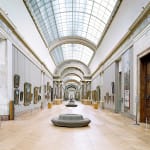
Candida Höfer German, 1944
Musée du Louvre Paris I 2005
Inkjet print
180 x 241 cm. (70 7/8 x 94 7/8 in.)
Edition of 6 (#1/6)
Copyright The Artist
